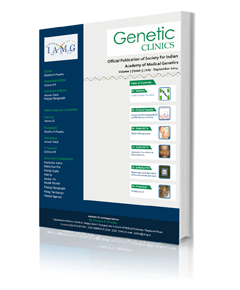| E-mail ID : info@iamg.in |
| E-mail ID : info@iamg.in |
Online Submission |
| Click Here For Online Submission |
| Instructions for authors |
Genetic Clinics |
| Editorial board |
Get Our Newsletter |
| Subscribe |
Send Your Feedback |
| Feedback Form |
About Us |
| IAMG |

Volume 8 | Issue 3 | July to September 2015 |
| Download Complete Issue |
| View Complete Issue |
GeNeDit |
|||
| July to September 2015| Vol 8 | Issue 3 | Page No 1 | |||
| Gene Darning for Gene Therapy | |||
| With the invention of recombinant technology
and the ability to cut/ paste genes, the immediate
goal was to correct genetic defects at the gene
level. In the early 1990s, we started showing hope
of gene therapy to families with thalassemia major. Shubha R Phadke |
|||
| HTML Full Text | Download PDF |
Clinical Vignette |
||||||
| July to September 2015| Vol 8 | Issue 3 | Page No 2-6 | ||||||
| Ring Chromosomes 13 and 14 presenting as intractable seizures- report of two cases with unusual features and review of literature | ||||||
| fling chromosomes "flC) result from terminal deletion
of chromosome arms, followed by fusion of
the broken ends leading to the loss of genetic
material. The phenotype is determined by the
chromosome involved and the extent of deletion.
fling chromosome "flC) is a rare cytogenetic abnormality Divya Pachat1, Karthik M2, Vivi Srivastava3, Maya Thomas2 and Sumita Danda1* |
||||||
| Abstract | HTML Full Text | Download PDF |
GeNeViSTA |
||||||
| July to September 2015| Vol 8 | Issue 3 | Page No 7-9 | ||||||
| Genetics of Alzheimer disease | ||||||
| Alzheimer disease (AD) is the leading cause of dementia
in the elderly. It is estimated to affect more
than 5.4 million people in the United States.1,2
Though the life span has been increasing consistently
in highly populous countries like India, no
such estimate is yet available on the incidence of Dhanya Lakshmi N |
||||||
| Abstract | HTML Full Text | Download PDF |
GeNeViSTA |
||||||
| July to September 2015| Vol 8 | Issue 3 | Page No 10-14 | ||||||
| Genome Editing: Precise and "CRISPER" | ||||||
| Creation of a desired change in the genome either
by gene addition/ gene insertion/ gene correction
at targeted sites is known as genome editing.
The various methods that are being conventionally
used for genome editing typically include a nucleotide
or amino acid sequence which identify the
targeted genomic site and a nuclease which Annapurna Gupta and Meenal Agarwal |
||||||
| Abstract | HTML Full Text | Download PDF |
GeNeXprESS |
||||||
| July to September 2015| Vol 8 | Issue 3 | Page No 15-16 | ||||||
| Genome editing technologies: Future of functional and therapeutic genetics! | ||||||
| All over the world, the procedure related risk of
miscarriage following an invasive prenatal testing
is quoted to be 1-2%. Akolekar et al. have
performed a meta-analysis of articles available
on MEDLINE, EMBASE, CINHAL and Cochrane library
in the period between 2000 and 2014.1 The
weighted pooled risk was estimated by 324 losses Meenal Agarwal |
||||||
| Abstract | HTML Full Text | Download PDF |
PhotoQuiz |
||
| July to September 2015| Vol 8 | Issue 3 | Page No 17 | This 6 year old boy, the second offspring of third degree consanguineous
parents, presented with progressively increasing deformity of bilateral elbow
and interphalangeal joints and nodular swellings on the Dr. Prajnya Ranganath |
|
| View PhotoQuiz | Click here to send your answer |
Announcements |
1. Second Annual Conference of Society for Indian Academy of Medical Genetics 2. Genzyme−SIAMG Fellowship in Clinical Genetics 3. Task Force on Lysosomal Storage Disorders 4. Indo - US Conference Realizing the Potential of Rare Disorders in India |
||
| Download PDF |